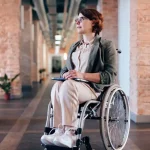Yes, it’s embarrassing, and you don’t want to mention the problem. But you know it won’t go away unless something is done.
It’s urinary incontinence and uncontrolled leakage of urine. It usually happens at the most inconvenient time for you as a caregiver and the patient.
There are many causes of urinary incontinence. It could be caused by a physical disability that affects the urinary system.
It could be caused by a loss of mental alertness, such as dementia. It can be a side effect of medication.
It can be caused by an undiagnosed condition or infection. It is not necessarily a result of aging.
Many people of all ages around the world have urinary incontinence. Drinking less fluid is not the solution, and in fact, that could make the bladder condition even worse.
It is not something that you loved one or patient intentionally does to embarrass you. Their incontinence does not make them a “bad” caregiver.
So, what can you do at home to make the accidents fewer?
- Avoid things that might irritate the bladder, such as artificial sweeteners, alcohol, and carbonated drinks or pop.
Be aware that some foods can cause bladder irritation, such as citrus fruits, tomato-based soups, stews and drinks, and spicy food.
Avoid caffeine which is in coffee, tea, and soft drinks. At least limit the caffeine, which is found in many beverages and foods. - Be sure to visit the toilet before bedtime. Take time there to completely empty the bladder.
Don’t drink beverages two to three hours before bedtime. - Drink 6 to 8 eight-ounce glasses of water, just plain water, every day. That is the hardest thing to do.
- Keep a schedule for toileting. Make a written schedule and keep it whether or not the “urge” comes at that time. Go every few hours.
- Don’t be reluctant to use adult-size disposable briefs or pads. These are made for men or women and come in various sizes, styles, and materials.
The products have different absorbency ratings, so read the package to find one that suits your needs. Keep trying these until you find one the patient likes.
When a patient wears an absorbent adult undergarment, a caregiver’s laundry loads and frustration are reduced considerably. - When you are out in public, go to the bathroom before shopping or getting back into the car to leave.
Put your package of disinfectant wipes and hand soap in your purse or case if you need to clean up.
Just in case of an accident away from home, keep extra pants and underwear/adult diapers in your bag or in the trunk of your car, so you will have dry clothing when you need it. Include a zip-up plastic bag for the wet clothing too.
Make your bathroom as safe as possible.
- Promote independence in the bathroom by putting in grab bars and raising the toilet seat. Or, use a portable toilet with arms around the toilet there.
- Dress in clothing that is easy to remove quickly.
- Keep the bathroom light on, and the pathway to the bathroom lit during the night.
- If the patient has mobility challenges, use a portable bedside toilet so that distance to the toilet is not an obstacle.
Ask a physical or occupational therapist about showing you how to help a physically disabled patient transfer to the toilet from a wheelchair, if needed.
Ask them about how to do that in a public handicapped toilet stall. - Keep on a schedule for toileting.
If the patient has dementia or limited cognitive or communication skills, then be observant of the clues indicating that they need to go to the toilet soon.
Bright colors get the attention of such people, so paint the bathroom door a bright color and get a matching bright-colored toilet seat.
Get some advice and help.
Don’t be too embarrassed to talk to your doctor about the problem. Some tests can determine the cause of incontinence, and there are treatments.
Most treatment plans involve a combination of medicine, behavioral modification, pelvic muscle exercises, collection devices, and absorbent products.
There are strengthening exercises called Kegel exercises which can help strengthen the pelvic area, and a physical therapist can help you learn to perform them.
Unfortunately, most people do not mention this problem to their doctor, so they continue to struggle and experience frustration and embarrassment about these “accidents.”
To Conclude
Suffering from urinary incontinence can be a tough and embarrassing challenge, but there are methods to successfully control it.
To minimize episodes and improve quality of life, limit irritants, stay on a toilet schedule, and use absorbent products. Plus, don’t forget to gain professional guidance as there are treatments available.
By utilizing these tips and consulting with a medical expert, those impacted by urinary incontinence can take measures towards managing their condition for an improved lifestyle!
Get more help online for urinary incontinence at the National Association for Continence website.

